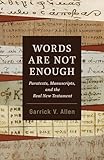Words are not enough : paratexts, manuscripts, and the real New Testament / Garrick V. Allen.
Publication details: Grand Rapids, Michigan : William. B. Eerdmans Publishing Company, c2024.Description: xviii, 198 pages : illustrations ; 22 cmContent type:- text
- unmediated
- volume
- 9780802883353
- 9781467466875
| Item type | Current library | Shelving location | Call number | Status | Date due | Barcode | |
|---|---|---|---|---|---|---|---|
 Books
Books
|
BSOP Library | GC | BS2325 Al5 2024 (Browse shelf(Opens below)) | Available | 00058751 |
Includes bibliographical references and index.
Machine generated contents note: Table of Contents List of Figures and Tables -- Preface -- List of Abbreviations -- 1. The Bible as Change -- 2. Materiality, Layout, and Paratext -- 3. Matthew in the Scofield Bible -- 4. Matthew and the Green Bible -- Titles -- 5. The Titles of the New Testament -- 6. Titles in Revelation and the Catholic Epistles -- Cross-References -- 7. Eusebius and His Paratextual System -- 8. Exploring the Euthalian Tradition -- Prefaces -- 9. Prologues and Divisions in Acts -- 10. Making Lists Out of Acts -- Traces of Use -- 11. Corrections and the Curious Case of the Codex Montfortianus -- 12. Daydreaming and Learning with the New Testament -- 13. The Margins and Biblical Scholarship -- Indexes .
"A study of the manuscript history of the New Testament, encompassing its paratexts-titles, cross-references, prefaces, marginalia, and more"--
"An innovative study of the manuscript history of the New Testament, encompassing its paratexts-titles, cross-references, prefaces, marginalia, and more. How did the Bible come to be? In Words Are Not Enough, Garrick V. Allen argues that our exploration of New Testament origins must take account of more than just the text on the page. Where did the titles, verses, and chapters come from? Why do these extras, the paratexts, matter? Allen traces the manuscript history of Scripture from our earliest extant texts through the Middle Ages to illuminate the origins of the printed Bibles we have today. Allen's research encompasses formatting, titles, prefaces, subscriptions, cross-references, marginalia, and illustrations. Along the way, he explains how anonymous scribes and scholars contributed to our framing-and thereby our understanding-of the New Testament. But Allen does not narrate this history to try to unearth a pristine authorial text. Instead, he argues that this process of change is itself sacred. On the handwritten page, Scripture and tradition meet. Students, scholars, and any curious reader will learn how the messy, human transmission of the sacred text can enrich our biblical interpretation"--


